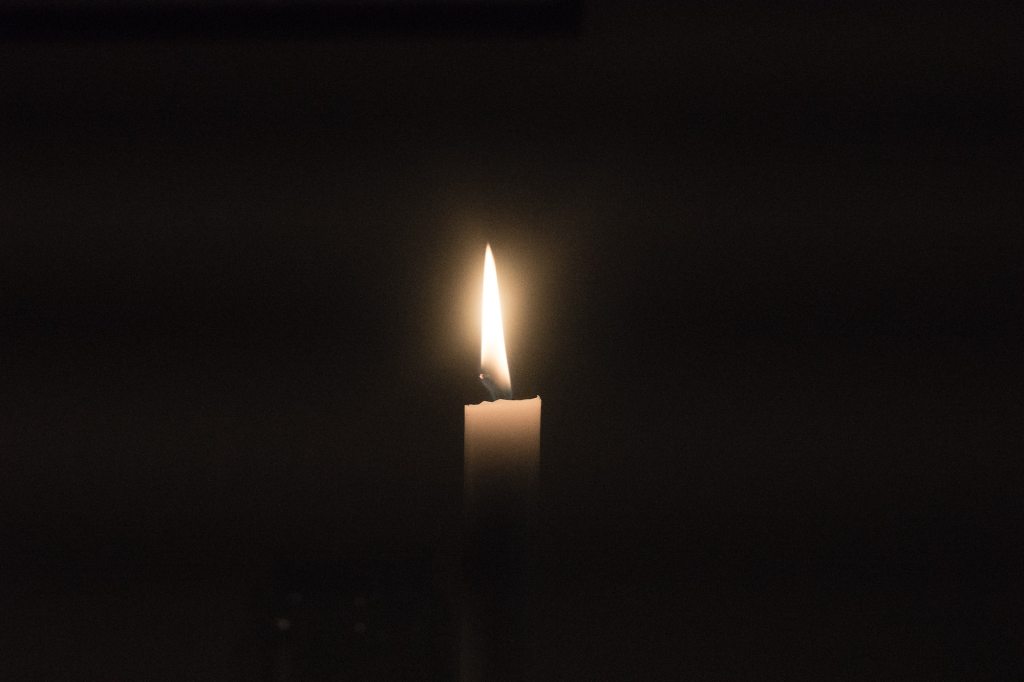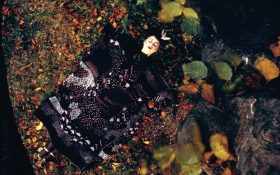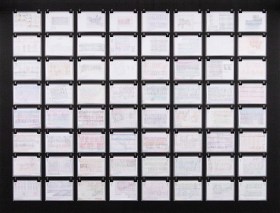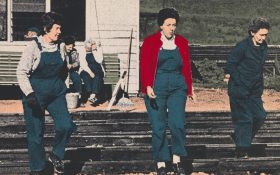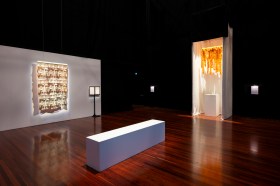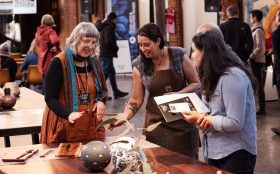Honouring:
Vale Bruce Armstrong (1957-2024)
Naarm/Melbourne born and based artist Bruce Armstrong was a diverse maker, and yet it was his sculptures that caught the imagination of the public.
Known best for his monumental totemic animals and figures, which were hewn from massive pieces of red gum and cypress using chainsaws, he was also an accomplished painter and printmaker.
Armstrong found his inspiration in the natural world at a time when formal abstraction, post modernism and conceptualism dominated the art world, graduating from the Royal Melbourne Institute of Technology (RMIT) in 1981.
It was the influence of his lecturer Jenny Zimmer that opened his eyes to animism and Egyptian art, and it was a path he would continue on for the next four decades.
‘They are all sorts of different things to different people,’ he told writer Ashley Crawford in an interview. ‘You can have a predatory bird, a nurturing bird – it’s a pet or a threat. I find they say more about people than people, in that their allegory is unrestricted. If it were a person doing what the owl is doing in these pictures, it would just be less interesting.’
As a result, Armstrong’s menagerie of birds and beasts have become place markers in our cities – among them is Eagle (Bunjil), which stands around 23 metres tall in the Docklands precinct of Melbourne, and Owl at eight metres tall, in the Canberra suburb of Belconnen.
While his sculptures had a mythological quality, they equally had a bodily and material connection to architecture.
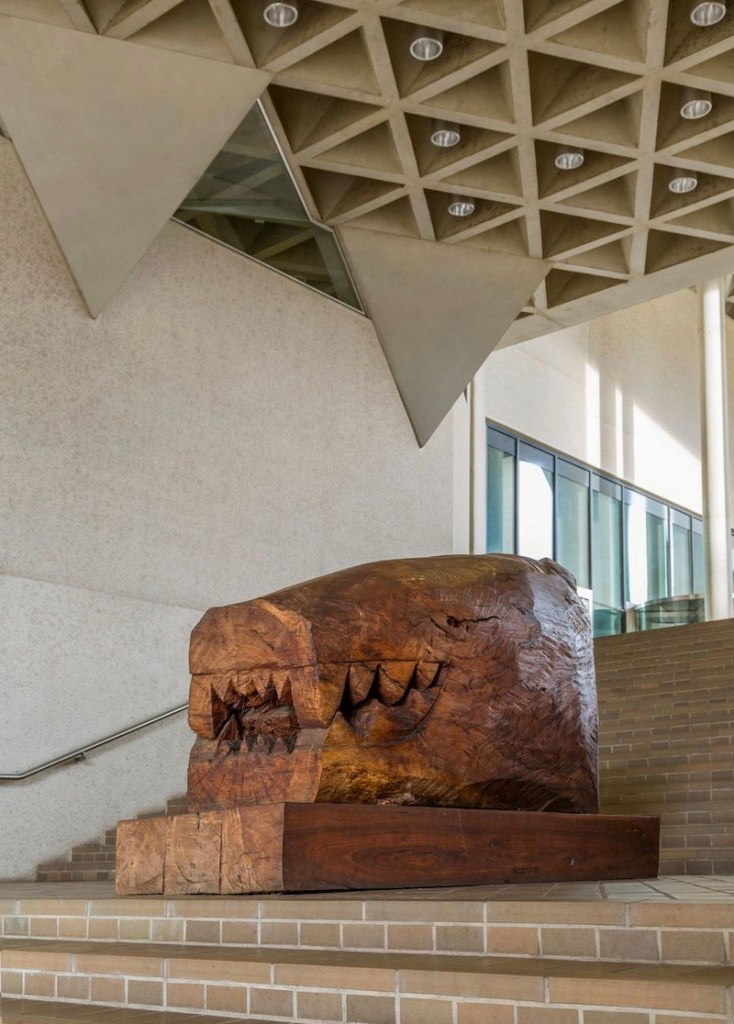
In a post on Instagram this week, the National Gallery of Australia celebrated Armstrong’s career, describing him as ‘one of Australia’s most revered sculptors… The National Gallery is very proud to hold eight of his works that form part of our foundational collection’.
Among them is Head 1986, which has sat on the outdoor staircase leading to the entrance and concourse since its acquisition, comfortably with the Gallery’s brutalist architecture.
The Gallery recalls Armstrong’s reflections on the piece (in 2002): ‘Looking back now at it, and the other works from around that time, I would say that my favourites are those that I didn’t contrive, but rather just facilitated. I was trying then, and still do try, to work quickly and directly, letting my imagination go in any direction it will.’
On his website, Armstrong described himself simply: ‘Mostly though I’m a studio-based artist who has occasional exhibitions at art galleries.’
Armstrong did have exhibitions across his 40-year career, most notably the survey exhibition Bruce Armstrong: An Anthology of Strange Creatures presented by the National Gallery of Victoria (NGV) in 2016, and staged over three floors of the Gallery.
Long before sustainability was a buzzword or hashtag, Armstrong embraced an environmentally alert studio practice, with wood shavings turned to garden mulch, and discarded chunks used for heating.
Armstrong’s works can be found in the National Gallery of Victoria, Art Gallery of New South Wales, National Gallery of Australia and the National Portrait Gallery collections, among others.
Finkelstein Gallery said of Armstrong on socials this week: ‘A giant among giants in the Australian art world, Bruce exemplified the quintessential hard yakka bloke and was loved by all who knew him. His work is his legacy, which shall live on through his iconic imagery.’
Vale Richard Dunn (1944-2024)
Having also battled cancer, Richard Dunn died peacefully in his home town of Sydney on 3 April after ongoing treatment. Dunn was an incredibly accomplished artist and teacher. He studied architecture at UNSW (University of New South Wales), sculpture at the National Art School in Sydney and painting at the Royal College of Art in London.
He was awarded the NSW Travelling Art Scholarship in 1966, judged by John Brack, and lived and worked for 10 years in London and Paris 1966-76.
Dunn’s CV reads like an illustrious roll call of the world great institutions and art world gongs: he was a fellow of the International Studio Program P.S.1 MOMA in New York from 1984–85; a guest professor at the National Academy of Fine Art, Oslo, in 2000; an artist-in-residence at the Kunstsammlungen Chemnitz in 2000; at Kunstakademie Dusseldorf for a semester in 2003/4; and artist-in-residence at Sanskriti Kendra, New Delhi, India in 2020.
He was also an External Examiner at Edinburgh College of Art for the Landscape Architecture MFA Art, Space & Nature (2009-2014).
That worldly perspective he brought back to Australia, first teaching painting and film studies at Sydney College of the Arts (SCA), University of Sydney in its first years 1977-1988, then becoming the founding Director of the new Sydney College of the Arts (1988-2001), and eventually Emeritus Professor of Contemporary Visual Art at the University of Sydney.
In terms of his own making, Dunn participated in five international Biennales and was the subject of two major solo German State Museum exhibitions at Kunstsammlungen Chemnitz (2004 and 2005). He had retrospective surveys at the Art Gallery of NSW in 1992 and Monash University Museum of Art in 1994, as well as over 60 solo exhibitions across commercial galleries.
In a social media post, Global Art Projects Melbourne said: ‘We worked with Richard many times over the years and he was always charming and professional to work with. He was a true thinker whose art reflected his great intelligence.
‘His beautiful work with its masterful practice made us think, made us consider our place in the world and the world generally. He was a compassionate man who will be sadly missed by the art world and his loyal friends.’
Dunn has also been shown in more than 100 group exhibitions in the US, England, France, Germany, China, Japan and Southeast Asia, and has also published widely in art journals and catalogues.
Dunn’s work is smart and layered, and often dealt with the complex problem of perception and interpretation, moving between minimal form and complexity of content. It is very much global contemporary art at its best.
In a formal statement, Dunn’s gallery, Charles Nodrum Gallery said, ‘His intellect, wit, humour and kindness will be sorely missed.’
In his foreword, to his 2023 survey monography, presented with the gallery, Richard Dunn: Thinking Pictures, Dunn wrote: ‘Art making is intuitive. It’s like thinking aloud, where the complexity of experiences can be reflected on in a way that may also resonate in others. So, art is also a social act… Art is similarly made up as one lives, but at the same time responds to very different conditions.’
He continued: Where one thing is placed in conjunction with another, I’m interested in how this changes the way we understand both. My inclination is to find surprise in this. If there is the temptation of repetition, my tendency is to approach a familiar idea from an unfamiliar position.’
Dunn is survived by his wife Suzanne Davies. He was 80.
Vale Gaetano Pesce, Richard Serra and Dinh Q Lê
While Richard Serra, Gaetano Pesce and Dinh Q Lê are not Australian artists, they all have had an enduring impact on the creative scene here, and have shown their work in Australia.
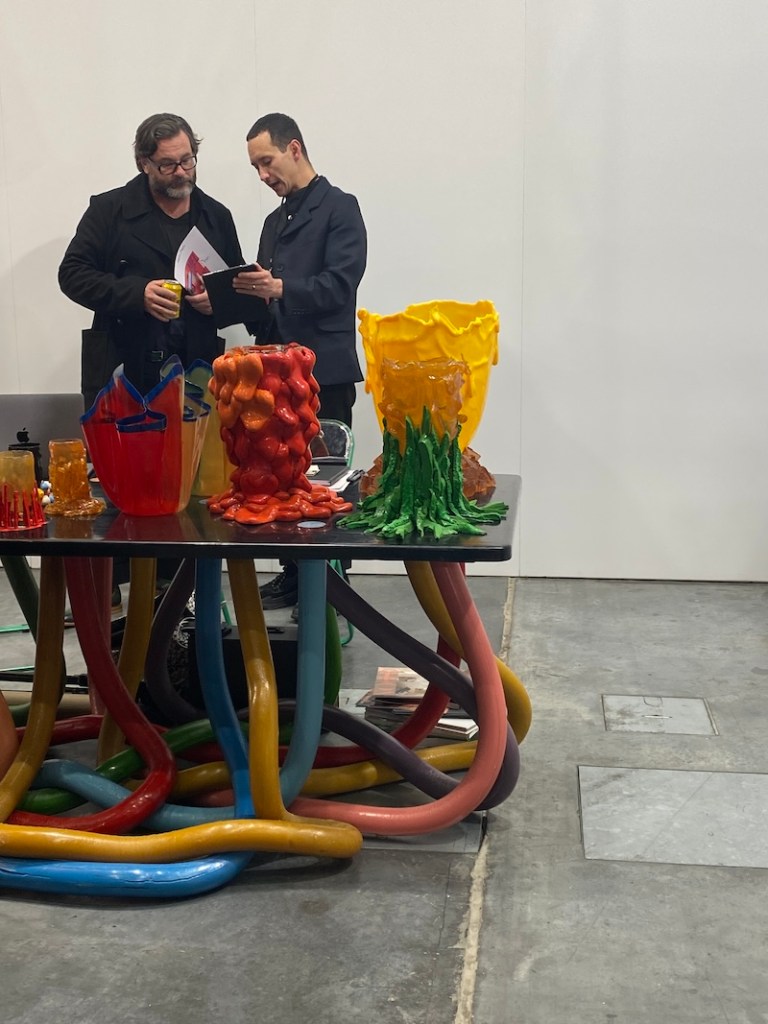
Gaetano Pesce
The renowned architect, artist and designer Gaetano Pesce (born Italy, 1939-2024), showed his work with the Melbourne’s gallery Neon Parc last year, and was a standout presentation at the last Melbourne Design Fair (May 2023).
Pesce emerged from the Florence-based group of designers and architects, the Italian Radical Design movement of the 1960s, which Neon Parc describe as ‘a forward-looking rebellion against the consumer-oriented industrial perfection of 20th century Modernism’.
Pesce’s works felt just as fresh as those origins when unveiled in Melbourne, and was an ambitious project for the gallery, pairing historical objects and sketches for larger projects, with recent chairs, lamps and vases rendered in his signature medium of urethane resin.
He was a global icon in the design world, and his pieces have been shown at MoMA in New York and the Centre Pompidou in Paris, among a coterie of 30-plus significant collections around the world. Learn more about Pesce.
Dinh Q Lê
Vietnamese-born, Dinh Q Lê (1968-2024) migrated to the US, escaping his home on the Cambodian border at 10 years old. Six of his siblings died on that journey. His story had a strong connection with many round the world, including Australia, where his work was exhibited a number of times.
It was first presented at the 2006 Asia-Pacific Triennial at Queensland Gallery | Gallery of Modern Art, then in group exhibitions at Casula Powerhouse – NAM BANG! (2009) and Refugees (2016) – and solo exhibitions with Sherman Contemporary Art Foundation, Sydney, Erasure (2011) and a self-titled exhibition Dinh Q Lê (2010) at Contemporary Art Centre of South Australia (CACSA) in Adelaide (folded into and rebranded as ACE).
Lê was best known for his photo-weaving technique, his From Hollywood to Vietnam series (2009) and later large-scale installations that incorporated video. Among these was Lê’s most famous work, The Farmers and the Helicopters (2006), a video installation pointing out the mismatch between Western and Vietnamese perspectives on the war. Across the last few decades, Lê’s work has been shown widely on the biennial circuit.
In later years he returned to Ho Chi Minh City to live. Lê’s longest-lasting legacy is Sàn Art, the Ho Chi Minh City art space that he co-founded in 2007. It has proven crucial in mounting independently organised shows in Vietnam. At the time of his death, Lê had been working on building a new studio – its progress shared with the art world on Facebook.
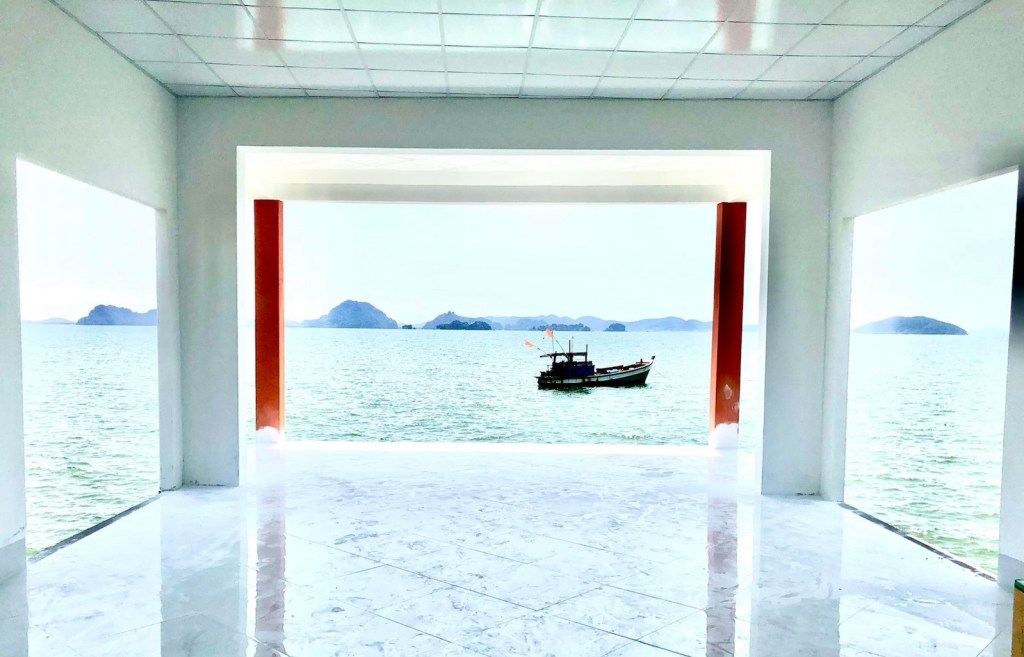
He died on 6 April, aged 56. Lê’s family announced his death on Facebook on Sunday, saying that he had suffered a stroke.
Richard Serra
Richard Serra’s name is synonymous with abstract sculpture and “heavy metal” a term applied to his weight fields of sheet metal that seemed weightless. He died from complications of pneumonia at 85, at his Long Island home in New York.
Arguably, many of his works offered the first immersive experiences for gallery visitors, squeezed within spaces and viewers having to navigate in, around and through his enormous forms.
Read: obituary for Richard Serra.
The San Francisco-born sculptor was no stranger to controversy – his installations Clara-Clara, unveiled in 1983 in the Tuileries Garden in Paris, and Tilted Arc (1981), in New York City’s Federal Plaza, were both vehemently protest against and eventually removed.
The National Gallery of Australia holds Prop in its collection holdings, an exclusive edition made for Leo Castelli Inc New York in 1968, as well as seven large-scale lithographs created in 1972, in the Gallery’s Kenneth E Tyler Collection.
This article was amended on 10 April 2024 to remove a misleading reference to Bruce Armstrong’s cause of death.
